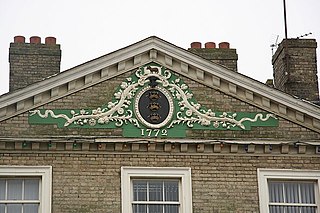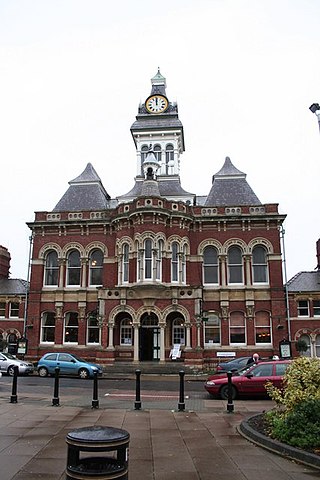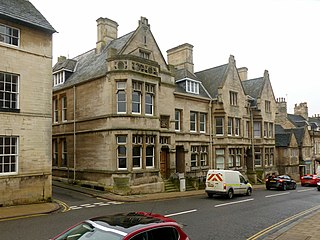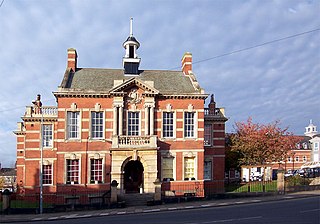
The Parts of Kesteven are a traditional division of Lincolnshire, England. This division had long had a separate county administration, along with the two other Parts of Lincolnshire, Lindsey and Holland.

Stamford is a town and civil parish in the South Kesteven District of Lincolnshire, England. The population at the 2011 census was 19,701 and estimated at 20,645 in 2019. The town has 17th- and 18th-century stone buildings, older timber-framed buildings and five medieval parish churches. It is a frequent film location. In 2013 it was rated a top place to live in a survey by The Sunday Times. Its name has been passed on to Stamford, Connecticut, founded in 1641.

South Kesteven is a local government district in Lincolnshire, England, forming part of the traditional Kesteven division of the county. Its council is based in Grantham, and the district also covers Bourne, Market Deeping and Stamford. At the 2011 Census, the population of the district was 133,788, at 1.4 per hectare in 57,344 households.

Market Deeping is a market town and civil parish in the South Kesteven district of Lincolnshire, England, on the north bank of the River Welland and the A15 road. The population of the town at the 2011 census was 6,008.

Grantham and Stamford is a constituency in Lincolnshire represented in the House of Commons of the UK Parliament since 2019 by Gareth Davies, a Conservative.

Thomas Lumby and William Lumby (c1755-1804) were master carpenters and architects working in Lincoln in the latter part of the 18th century. Thomas Lumby was the father of William. As they worked together and there is some confusion as which buildings each of them designed, they have been grouped together. It seems likely that after 1784, William Lumby had taken the business over from his father. Thomas Lumby undertook work at a number of major houses in Lincolnshire including Doddington Hall and Burghley House as well as building Caenby Hall and Corporation House (now the Exchange at Boston, Lincolnshire.

Edward Browning was an English architect working in Stamford.

Grantham Guildhall is a municipal building on St Peter's Hill, Grantham, Lincolnshire, England. It is a Grade II listed building.

Joseph Boothroyd Corby (1839–1913) was an English architect who worked in Stamford, Lincolnshire.

Bourne Town Hall is a municipal building in North Street, Bourne, Lincolnshire, England. The town hall, which was the headquarters of Bourne Urban District Council, is a Grade II listed building.

Folkestone Town Hall, also known as The Guildhall, is a municipal building in Guildhall Street, Folkestone, Kent, England. The town hall, which was the headquarters of Folkestone Borough Council, before it was converted to house the Folkstone Museum. It is a Grade II listed building.

Bridgwater Town Hall is a municipal building in the High Street, Bridgwater, Somerset, England. The town hall, which was the headquarters of Bridgwater Borough Council, is a Grade II listed building.

Cleethorpes Town Hall is a municipal structure in Knoll Street, Cleethorpes, Lincolnshire, England. The town hall, which was the headquarters of Cleethorpes Borough Council, is a Grade II listed building.

Whitehaven Town Hall is a municipal building in Duke Street in Whitehaven, Cumbria, England. The building, which was the headquarters of Whitehaven Borough Council, is a Grade II listed building.

Devizes Town Hall is a municipal building in St John's Street in Devizes, Wiltshire, England. The structure, which is the meeting place of Devizes Town Council, is a Grade II* listed building.

Louth Town Hall is a municipal building in Eastgate in Louth, Lincolnshire, England. The structure, which was the meeting place of Louth Borough Council, is a Grade II listed building.

Market Deeping Town Hall is a municipal structure in the Market Place, Market Deeping, Lincolnshire, England. The structure, which is the meeting place of Market Deeping Town Council, is a Grade II listed building.

Lutterworth Town Hall is a municipal building in the High Street in Lutterworth, Leicestershire, England. The structure, which operates as a community events venue, is a Grade II listed building.

St Ives Town Hall is a municipal structure in Market Hill, St Ives, Cambridgeshire, England. The structure, which is the meeting place of St Ives Town Council, is a Grade II listed building.

The Town House is a municipal building in Union Street in Yeovil, Somerset, England. The building, which is the meeting place of Yeovil Town Council, is a Grade II listed building.





















